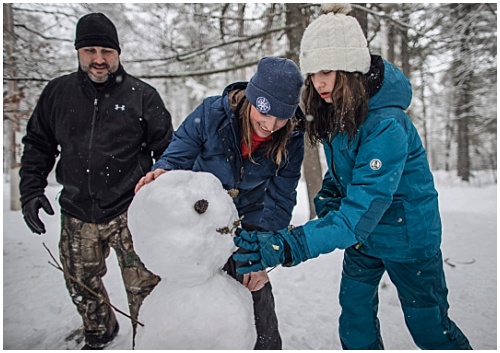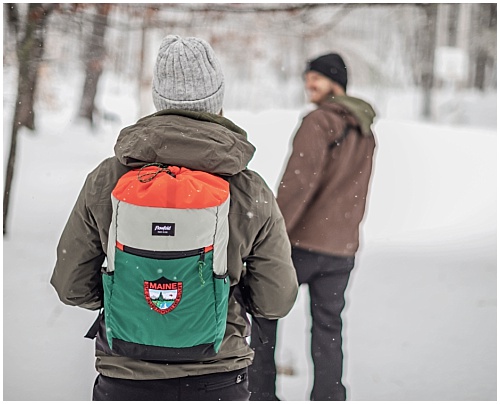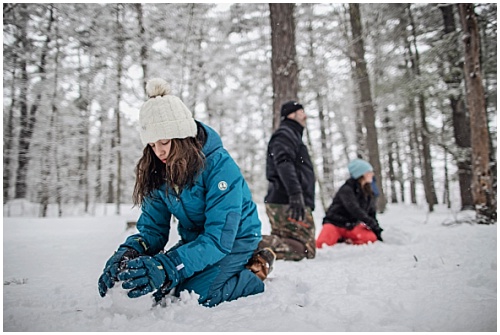January 28, 2021 at 3:32 pm
The key to a fun day of walking, ice fishing, snowshoeing, cross-country skiing, or wildlife watching in the winter is staying warm and being prepared. Here are a few tips from Maine Game Wardens, biologists, and staff to make sure you (and your children) stay warm and dry this winter:

1. Wait to put your socks and boots on until you arrive at your destination.
“My feet and fingers get cold remarkably easy so I’ve learned to keep my boots under the foot heat vents with a dry pair of socks so they’re pre-warmed and ready when I get to my destination. I also really love wool everything to keep comfortable: hat, socks, glove liners, and base layers. I always keep a thin shell in my backpack in case I need something to block the wind, usually just lightweight rain gear. My favorite winter activity is cross country skiing, but this winter I hope to do more ice fishing.”
– Sarah Spencer, Wildlife Biologist
2. Regulate body temperature, keep yourself dry from the inside out, and pack multiple pairs of mittens, especially when venturing with children.
“While out winter trapping with my kids, my number one priority to ensure a fun, rewarding experience is keeping them dry. Moisture from the inside (sweat) and the outside (rain, snow) can quickly ruin an outing and in extreme situations lead to hypothermia and life-threatening situations. Hauling tote sleds and pack baskets full of traps through the snow can be hard work. Ensuring my kids are dressed appropriately from the inside out begins before leaving the house. Suitable materials (no cotton) and numerous lighter layers with zippers which can be opened and closed are key to regulating their body temperature and ensuring they do not work up a sweat as we walk to our spot. Once we get to a location and begin our setup (which may cause us to be stationary for an hour or more) fleeces can be zipped back up and wool hats donned to trap body heat inside a base-layer which is as dry and warm as we started. In windy conditions, a windbreaker pulled on as an outermost layer can make all the difference to how long we can stay.
Especially with young people, hands and feet get cold. Ensuring boots are waterproof and not too tight (causing sweaty socks) is important to keep warm blood flowing to the toes. Cold toes can often be warmed up by getting active again and walking around, but once socks get wet, you might as well ‘head for the barn.’ If you are participating in an activity where wet fingers are inevitable (ice fishing, water trapping, etc.) plan for multiple pairs of mittens (or hand muffs), always designating the warmest pair as the ‘always dry pair.’ I often bring a towel or some other cloth to dry off small hands so the only fingers returning to the ‘always dry mittens’ are…well… ‘always dry.’ A few minutes in a warm, dry pair of mittens accompanied by a handwarmer will keep you and your child headed for more fun as opposed to the truck. Finally, a backup pair of dry socks or gloves stored in a vehicle may help to turn a four-hour outing into an eight.”
– Dan Scott, Game Warden Colonel
3. Pack hand and toe warmers, and don’t forget to drink water.
“I always keep hand warmers and toe warmers in my pack. Like many others, my hands and feet tend to get cold first. I also bring plenty of water. It is just as important to stay hydrated in winter as it is in summer. My winter activities include ice fishing and hiking with my pup.”
-Carl Tugend, Assistant Regional Wildlife Biologist in Region C

4. Dress in layers. If winter hiking, gaiters, trekking poles, and crampons are very helpful.
“I love winter hiking, so my biggest advice is to dress in layers! A base layer is so important, but avoid cotton. I suggest a base layer made from Merino wool. It’s worth the investment! Gaiters, trekking poles, and crampons are a good investment too. Check the weather forecast, be prepared, and stay safe!” – Cynthia Rego, Office Associate II
5. Rubber insulated boots and layers are key! But one pair of wool socks is plenty – layering socks is not recommended.
“I am a huge fan of insulated rubber boots as they keep your feet warm and dry. I’m also a huge fan of layers. You can always take layers off and it is better to have it and not need it, than need it and not have it. I echo the water statement from Carl as well. I am guilty of not drinking enough water in the winter. Lastly, I have seen folks during winter fieldwork make the mistake of wearing too many pairs of socks. The idea behind insulation requires some level of airflow. Too many layers of socks jammed into your footwear can cause your feet to feel colder than if you wore one nice pair of wool socks instead of layering two or three pairs on your feet.
My favorite way to enjoy the winter is pond hockey closely followed by skiing. However, when time is limited, I enjoy hiking in the woods with my wife and dogs. We also started skijoring with our horses. It’s a lot of fun!”
-Connor White, Wildlife Management Institute Contract Wildlife Biologist
6. One of the best ways to stay warm is actually to keep from getting overheated at times when you can avoid it. Bring a warm snack and keep the kids engaged for a fun day.
“Being outside in the winter is an exercise in temperature management. This starts with dressing in layers and having a good wicking base layer against your skin (don’t wear cotton!). Always take the extra time to think and remove layers if the activity will involve a raise in body temperature. The obvious is to remove jackets and hats when doing a high-intensity aerobic activity such as hiking into a remote pond, cutting holes with a chisel, or pulling a tote sled. The not so obvious is to have the forethought to remove layers prior to getting overheated when doing an activity such as freeing a stuck snowmobile. It takes only a few moments to remove gear and put it on again that can make the difference on being cold and wet from sweat or comfortable the rest of the day.
Little comforts can go a long way. On cold days there is nothing better than being able to have a warm lunch. A little preparation before you leave the house can keep you warm and happy. A wide-mouth thermos preheated with boiling water, then filled with a carbohydrate and protein-rich meal such as pasta and meat sauce or chili (overheated in the microwave) can save the day and keep you in the field longer.
Some special tips for young children and winter outdoor activities:
- Keep good tabs on just how wet or cold they are getting. Children have a tendency to not complain until it is too late.
- Keep spare socks or mittens handy.
- Be prepared to return to the truck for a little warm-up session as well, sometimes when a child gets too cold all it takes is a few minutes in the heat and a fresh pair of mittens.
- Keep them engaged by giving them a task even if it is something simple like holding the ice skimmer, or keeping your gloves off the ice when cutting holes.
- With young kids be prepared to let them play. Don’t get so bogged down in the activity that it doesn’t become fun for them. There have been times that playing Paw Patrol or building a snow fort becomes a priority when checking traps or shed hunting and that’s okay!
- Entice your children with the novelty of outdoor wintertime sports. A well-timed and unexpected hot dog cooked on a fire or thermos of hot chocolate emerging from a pack will keep them interested.
- If you want to enjoy winter activities with your children…know when to call it a day. Pushing children to stay out longer will result in them not wanting to enjoy outdoor time.
And finally, keep a bag with emergency gear ready. This bag can be vacuum sealed to save space in a pack. Keep items like spare socks, gloves, a headlamp, and fire-starting equipment (raid the dryer for some lint to use as tinder!) and a high-calorie snack. Let someone know where you are going and when you plan to return. My little girls and I enjoy beaver trapping in the winter and early spring months.” – Eric Rudolph, District Game Warden – Ellsworth patrol

7. Pay attention to the weather, and dress for the activity.
“It is always important to check the weather and start making it a habit to track the weather and see what is going on each day. Pay attention to what storms might be coming or temperature changes in the near future. Rain or snow a few days before can change ice conditions and trail conditions so it is good to learn what different weather means for what you might be doing.
Whether I am ice fishing or snowshoeing my base layers start the same. I always choose something quick-drying, preferably my Merino wool. When going snowshoeing I tend to start off with fewer layers because I warm up quickly but pack extra layers (and extra, dry pairs of socks, a hat, and mittens) in a bag for when I stop or cool down. Other layers include fleece, a down vest, jacket, snow pants, and a windbreaker.
I am such a kid at heart that I always wear waterproof snow pants because I will inevitably sit in the snow or kneel right next to my ice fishing hole and if I am not water proof, I get wet. My boots are usually my snow boots which are fairly waterproof still or my tall, insulated rubber boots. I prefer my snow boots for snowshoeing because they are more flexible, and taller boots for ice fishing. My favorite winter pastimes include ice fishing, wildlife watching, and snowshoeing. Don’t forget a pair of binoculars! “ – Laura Craver-Rogers, Education & Outreach Supervisor
To learn more about being prepared, check out MDIFW’s outdoor enthusiast’s guide: You Alone in the Maine Woods (PDF).